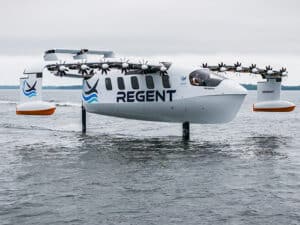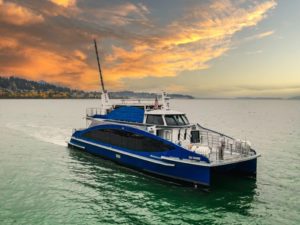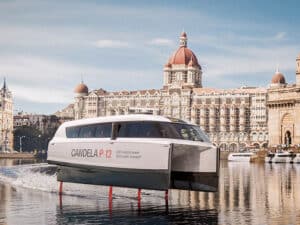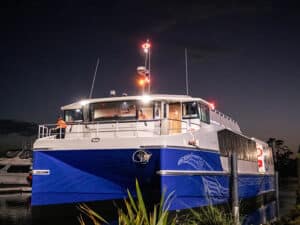
Passenger ferry designers look ahead
Written by Nick Blenkey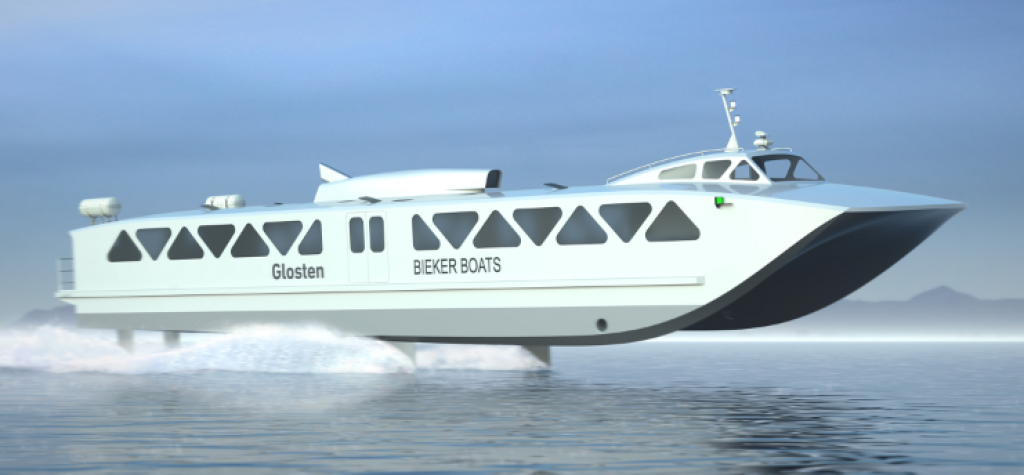
Foil ferry design being developed by Washington State project features composites hull, hydrofoils and electric drive option. [Glosten]
Though the COVID-19 pandemic has put a dent in recent passenger demand, designers are looking ahead to a, hopefully, brighter future with a slew of interesting new and greener designs.
An innovative foil assisted fast ferry design, first announced in January of last year, is now a lot closer to moving from concept renderings to on-the-water reality. The design is the creation by two Seattle firms: naval architecture and marine engineering firm Glosten, and a performance marine craft designer Bieker Boats.
A consortium of Washington State players has now gotten behind the project and launched a Joint Innovation Project (JIP) to speed things along.
The public-private partnership includes three ports that have joined forces to support the effort: Port of Anacortes, Port of Bellingham, and Port of Skagit. Operator Kitsap Transit has identified a potential route for the vessel in its ferry operations and sponsored the team in applying for additional funding to advance the concept.
Leading the collaborative effort are Washington Maritime Blue, an initiative set up in 2017 by Gov. Jay Inslee, and class society DNV GL. Project partners also include Skagit County and EDASC (Economic Development Alliance of Skagit County).
The idea first began when Paul Bieker, naval architect and Bieker Boats partner, returned to Seattle after his work designing the first hydrofoil vessel for the Americas Cup-winning Team Oracle and was stunned by the traffic. He realized that applying hydrofoil innovations to ferry vessels would improve speed, efficiency, and access. Working with Glosten, a preliminary design was created.
The project will develop a replicable business model for an efficient electric transit concept: a high-speed hydrofoil passenger ferry with innovations that include hydrofoil design, lightweight carbon fiber construction, and battery technology.
It supports transit options by connecting urban, suburban, and rural communities with green transit alternatives that can take cars off the roads.
Because of the nature of JIPs, the expected time it will take to complete the entire project, from business model to the first demonstration project, is compressed.
Several streams of work will occur either in parallel or in succession, as appropriate, creating efficiencies and avenues to take advantage of the collective strengths of each of the organizations involved. The design includes the options of fully electric propulsion or diesel-electric propulsion for extended range.
“Until now, ‘high-speed ferry’ and ‘all-electric’ have not belonged in the same sentence,” says a Glosten Project Manager Matthew Lankowski. “Slower all-electric ferries are now operating thanks to advancements in battery technology over recent years. However, the energy required by conventional fast ferries is too great for economical storage in batteries. Hydrofoil technology smashes through this obstacle by dramatically reducing the energy required to operate at high speeds.”
“Advancements in carbon fiber design and construction are also a critical enabler of this design,” he added. “Reduced hull weight and strong, lightweight foils free up the weight allowance needed for the batteries and propulsion system.”
“In addition, huge advancements with electronics and control software has made hydrofoil flight control much simpler, less expensive, and more reliable than it has been in the past,” added Bieker.
The fast hydrofoil is not, of course, the only green ferry initiative in Washington State. Somewhat up the ferry size scale, Washington State Ferries (WSF) is in the midst of a long-term program for electrification of its ferries under its 2040 long range plan, an updated version of which was set to be submitted to the state legislature this month. We’ve covered the WSF plan extensively in the past, but its worth mentioning that it has involved a number of visits to Norway that can claim a world lead in many aspects of green ferry development.


